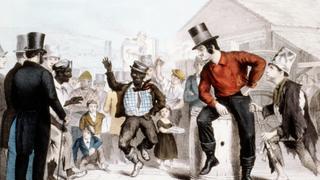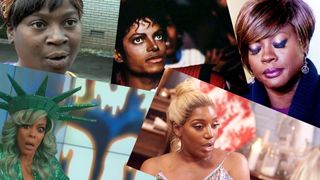Digital blackface describes the act of producing, posting or circulating ‘black reaction gifs’ online and especially on social media threads.
Someone watching a drama unfold might post Michael Jackson settling into the cinema with a box of popcorn. Real Housewives of Atlanta offer that withering bit of side-eye or a manicured hand, raised to dispense with an annoyance. The celebratory outburst of a rap battle could punctuate a clever message.
But the internet’s habit of using the faces of black people as emphatic emojis has begun attracting scrutiny. Critical accounts of the practice have recently appeared on the BBC and in The Guardian, and Teen Vogue. Digital blackface is questionable because it re-enforces stereotypes of black Americans as exaggeratedly comic personae, or, especially in the case of women, as archly sassy, but in a way that does not detract from their fundamental availability to the project of white identity construction.
“Because they think they are white…”
Digital blackface raises the question of how and why the distinction between white and black is made in American society. The belief in whiteness — which implies the converse belief in blackness — is, according to the novelist and social critic James Baldwin, a safe delusion. It excuses the nation from the intellectual rigor required for social justice. “Because they think they are white, they dare not confront the ravage and the lie of their history,” Baldwin writes, in one of his most salient critiques of America’s racial imagination.
Digital blackface satisfies the temptation for internet users to overlay their own face with “black cachet”. In the same act, they risk avoiding the “the ravage and lie” of a history that made such an identification tempting yet complex. As Baldwin defined it, the paradox of race in America meant that in their “debasement and definition of Black people”, those who decided that they were, by contrast, white, “debased and defamed themselves”.
Discussions of digital blackface are important because they provide an opportunity for Americans, and especially young Americans, to consider again the question Baldwin raises: How does one come to think of themselves as white or black? How does one face the “ravage and lie” of American history? How does one attempt to undo the dehumanisation and debasement of blackness upon which the construction of whiteness depended?
Understanding the critique of digital blackface thus requires a deep historical context, a sensitivity to the rituals of imitation and humiliation have been durable features of US popular culture since the early 1800s.
The complicated history of minstrelsy
Transgressions of class, race and gender identity have been a mainstay of American performance culture since the early 1800s. These impulses continue to animate the production and performance of social identities online, but their cultural emergence is a matter of some historical complexity.
At the turn of the nineteenth century, the freeing of slaves in New York and New Jersey saw the transit of free black men and women through the urbanising north-eastern United States.
In the diverse and working class “Five Points” section of lower Manhattan — immortalised somewhat fatuously by Martin Scorsese’s Gangs of New York — the Catherine Street Fish Market was a site where a black street culture thrived, especially as market hawkers organised dance-offs to win baskets of eels. The historian W.T. Lhamon writes that sites like these were defined by an “eagerness to combine, share, join, draw from opposites, play on opposition”.
Lhamon also sees dancing for eels as the root of American blackface, since the fascinated market audience, both black and white, were organised by a desire to overlay ‘black cachet on their own identities — even as their own identities”.

Lower Manhattan was also the home of a singularly important figure in the rise of blackface — performer T.D. Rice. Rice mingled in culturally porous spaces like Catherine Market, and, after living amid black street life, developed his infamous blackface stage character, Jim Crow. Rice’s Jim Crow is a socially-mobile trickster figure, whose ability to turn and wriggle in an exaggerated dance complemented his ability to avoid the disciplinary apparatus of a punitive and racist society.
Rice travelled internationally with his Jim Crow act. He was a huge sensation in London, and claimed that his performance (which originated the device of painting one’s face black) was designed to stress black humanity. Rice saw himself not as a ridiculer but an advocate.
To add to the complexity, Rice’s imitation of the black trickster figure overlays the practice of imitative dance that occurred on slave plantations in the American south. On rare days of recreation, slaves would sometimes ridicule the French minuet — a fashionable dance they observed in the master’s house — in a competition that awarded the winner a cake, earning these dances the name “cakewalks.”
Taking a different perspective on minstrelsy, Eric Lott’s book Love and Theft stresses some of its homoerotic premises, the mixture of desire and repulsion that defined the racial fantasies of the white working class. It is worth noting that working-class white performers often targeted the pretensions of the upper classes through the proxy of the upwardly mobile black character.
Throughout the 1800s, white performers increasingly “blackend-up” to eviscerate black Americans behind the pretext of humour, entertainment or class critique. Songs like “Zip Coon” — and the entire genre of the “coon song” — were petty, relentless and cruel in presenting African-Americans as idiotic dopes, aspirational buffoons or irreformable bumpkins.
Notwithstanding the racism of the practice, minstrel shows overlapped with the broader culture of working class entertainments, including burlesque, circus and vaudeville. Thus the term “minstrel show” can refer also to genres of black performance. Incidentally, minstrel shows are at the root of the careers of many iconic blues musicians, including Bessie Smith and Little Richard, and the legendary songwriter Curtis Mayfield would later reclaim the figure of the minstrel in his beautiful love song “Minstrel and Queen”.
The practice of entertainers — both white and black — applying burnt cork or shoe polish to their faces continued into early twentieth-century screen and stage cultures, but became rightly unpalatable in the age of civil rights equality. Modern America’s archive of racially charged characterizations is catalogued ominously in Spike Lee’s film Bamboozled.
Digital justice
Although it was built out of complex rituals and alloyed identities, this history of blackface inscribed human beings with pernicious stereotypes, deepening a racial superstition that continues to stymie American politics and society today. The reinvention of blackface in a digital era is a call to revisit the worst fantasies of American history, to avoid repeating its injustices, and to recognise — as Baldwin did —that in denigrating and debasing another, one denigrates and debases oneself.





